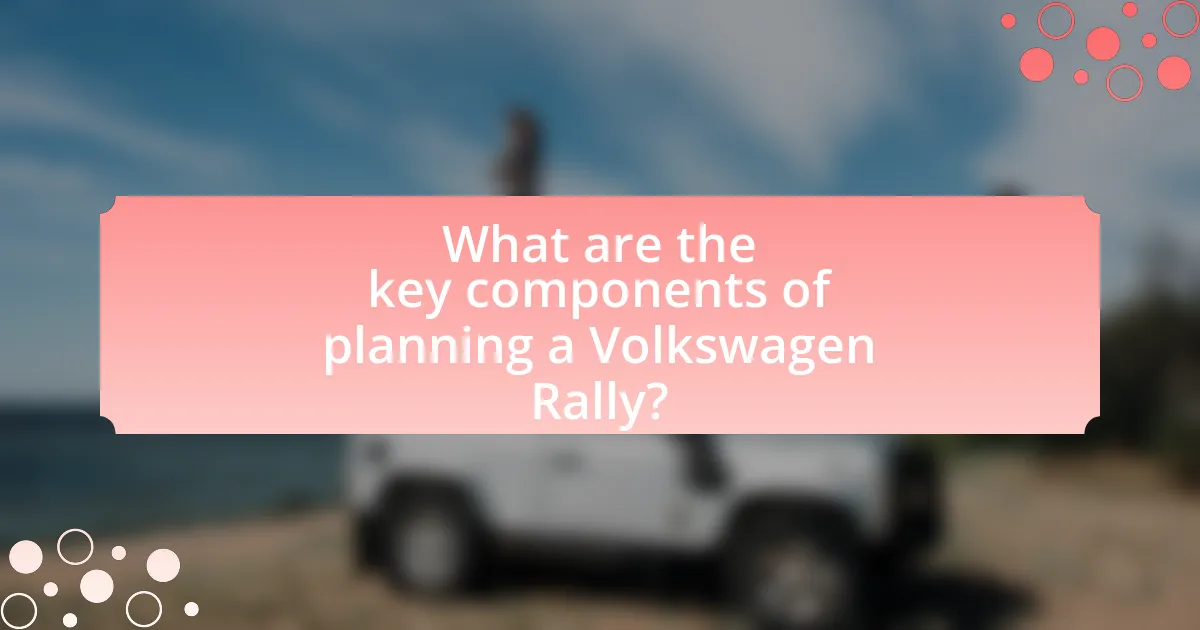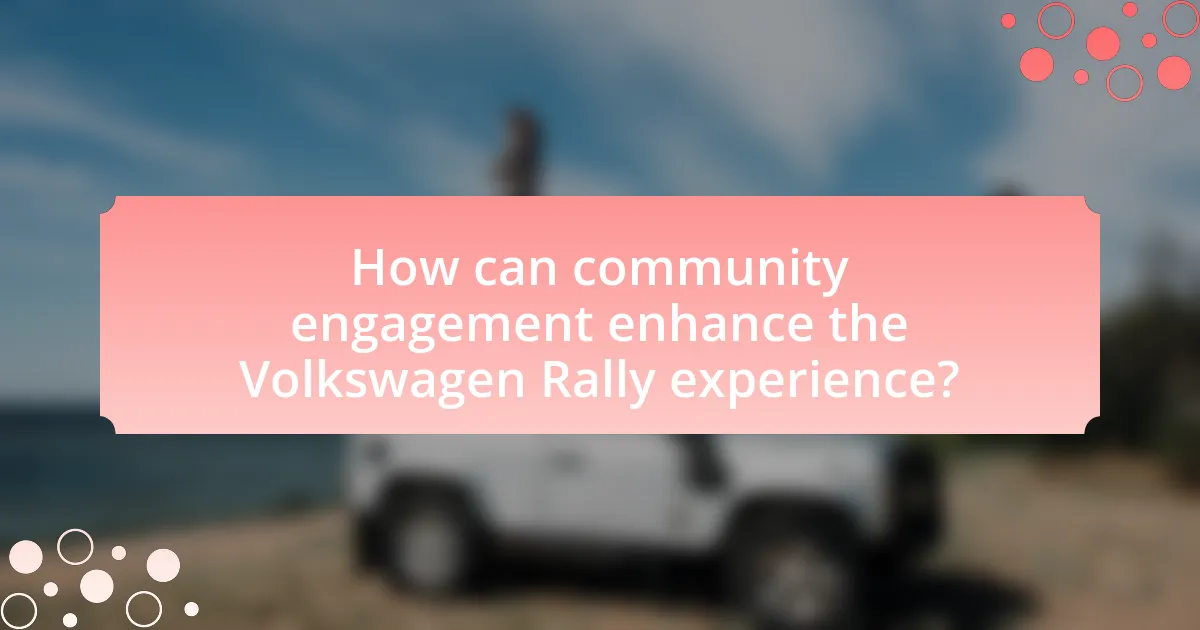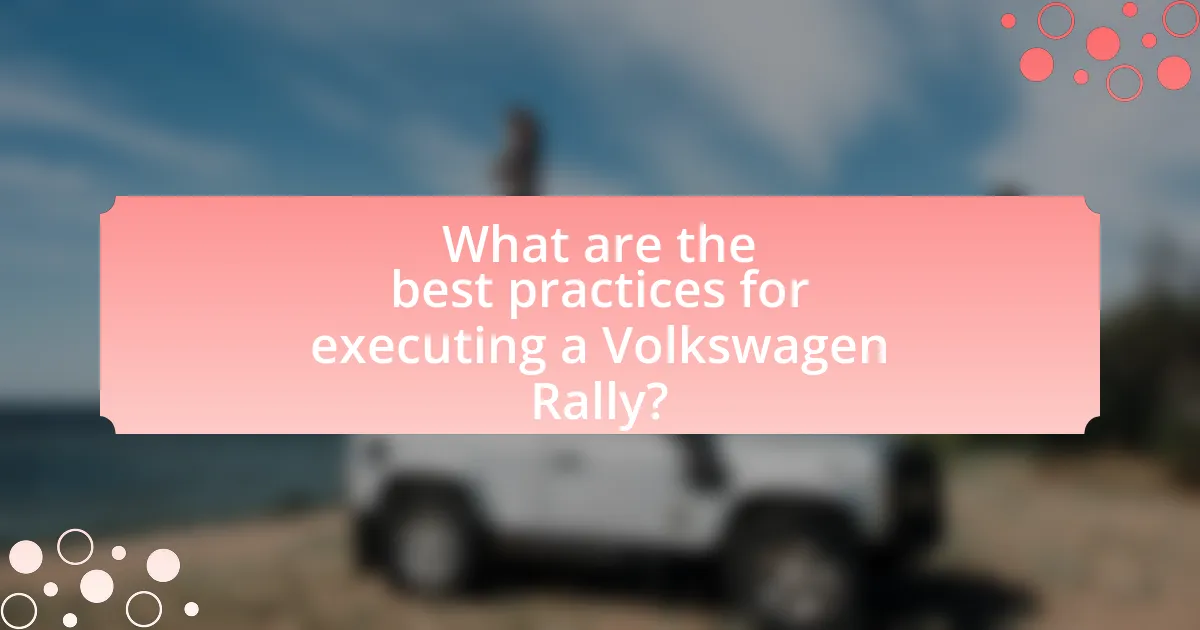The article focuses on the essential components of planning a Volkswagen Rally, emphasizing logistics management, route selection, participant engagement, sponsorship acquisition, and safety protocols. It outlines the criteria for determining rally locations and venues, highlighting factors such as accessibility, capacity, and community interest. Additionally, the article discusses the importance of effective budgeting, securing permits, and fostering community involvement to enhance the rally experience. Strategies for managing transportation, ensuring participant safety, and leveraging social media for engagement are also examined, along with best practices for post-event activities that strengthen community ties.

What are the key components of planning a Volkswagen Rally?
The key components of planning a Volkswagen Rally include logistics management, route selection, participant engagement, sponsorship acquisition, and safety protocols. Logistics management involves organizing the event’s infrastructure, such as securing venues, arranging accommodations, and coordinating transportation for participants. Route selection is crucial, as it determines the driving paths and scenic stops that enhance the rally experience. Participant engagement focuses on creating activities and fostering community among attendees, which can include social events and competitions. Sponsorship acquisition is essential for funding the event, requiring outreach to potential sponsors who align with the Volkswagen brand. Lastly, safety protocols must be established to ensure the well-being of all participants, including emergency plans and compliance with local regulations. These components collectively contribute to a successful and enjoyable Volkswagen Rally.
How do you determine the location for the rally?
To determine the location for the rally, organizers assess factors such as accessibility, safety, and community interest. Accessibility ensures that participants can easily reach the venue, while safety involves evaluating the site for potential hazards. Community interest is gauged through surveys or local engagement to ensure the rally resonates with the target audience. For instance, a successful rally location often has ample parking, nearby amenities, and is situated in a region with a strong Volkswagen enthusiast community, which can be validated by local club memberships and past event attendance statistics.
What factors should be considered when selecting a venue?
When selecting a venue for a Volkswagen Rally, key factors include location, capacity, accessibility, amenities, and safety. The location should be easily reachable for participants and spectators, ideally near major transportation routes. Capacity must accommodate the expected number of attendees, ensuring comfort and safety. Accessibility is crucial for individuals with disabilities, requiring compliant facilities. Amenities such as restrooms, food vendors, and parking enhance the experience. Safety considerations include emergency access and crowd management plans, which are vital for large gatherings. These factors collectively ensure a successful and enjoyable event.
How does the location impact participant experience?
The location significantly impacts participant experience by influencing accessibility, ambiance, and engagement opportunities. For instance, a rally held in a scenic area can enhance enjoyment through picturesque views and recreational activities, while a location with easy transportation links can increase attendance and participation. Research indicates that events in well-chosen locations can lead to higher satisfaction rates among participants, as evidenced by a study from the Event Marketing Institute, which found that 78% of attendees consider location a critical factor in their overall experience. Thus, the choice of location directly correlates with the quality of participant engagement and satisfaction.
What logistical elements are essential for a successful rally?
Essential logistical elements for a successful rally include route planning, permits, safety measures, and participant coordination. Route planning ensures that the rally follows a safe and engaging path, while obtaining necessary permits from local authorities is crucial for legal compliance. Safety measures, such as medical support and traffic management, protect participants and spectators. Additionally, effective participant coordination, including registration and communication, enhances the overall experience and ensures smooth operations. These elements are supported by successful rally examples, such as the annual Volkswagen Rally, which emphasizes thorough planning and community involvement to achieve high attendance and participant satisfaction.
How do you manage transportation and parking for participants?
Transportation and parking for participants are managed by coordinating shuttle services and designating specific parking areas. Shuttle services are scheduled to run at regular intervals, ensuring timely transport from central locations to the rally site, which enhances accessibility. Designated parking areas are strategically located to accommodate the expected number of vehicles, with clear signage to guide participants. This approach minimizes congestion and ensures a smooth flow of traffic, supported by historical data indicating that organized transportation reduces wait times by up to 30%.
What permits and regulations must be addressed?
To plan a Volkswagen Rally, organizers must address several permits and regulations, including event permits, road use permits, and safety regulations. Event permits are typically required from local authorities to ensure the rally complies with municipal guidelines. Road use permits are necessary to secure permission for using public roads, especially if the rally involves road closures or detours. Safety regulations, including crowd control measures and emergency response plans, must also be adhered to, as mandated by local law enforcement and public safety agencies. Compliance with these permits and regulations is essential to ensure the event is legally sanctioned and safe for participants and spectators.
How can you effectively budget for the rally?
To effectively budget for the rally, start by identifying all potential expenses, including venue costs, permits, insurance, marketing, and supplies. A detailed breakdown of these costs allows for accurate financial planning. For instance, securing a venue may require a rental fee, which can range from $500 to $5,000 depending on location and size. Additionally, obtaining permits can incur costs of $100 to $1,000, while insurance might add another $200 to $1,500. By compiling these figures, you can create a comprehensive budget that ensures all necessary expenses are accounted for, ultimately leading to a successful rally.
What are the main cost categories to consider?
The main cost categories to consider when planning a Volkswagen Rally include venue rental, permits and insurance, marketing and promotion, equipment and supplies, staffing, and transportation. Venue rental encompasses the costs associated with securing a location for the event, while permits and insurance cover legal requirements and liability protection. Marketing and promotion involve expenses related to advertising the rally to attract participants. Equipment and supplies refer to the necessary materials for the event, such as signage and safety gear. Staffing costs include wages for event personnel, and transportation covers logistics for moving equipment and participants. Each category is essential for ensuring the successful execution of the rally.
How can sponsorships and partnerships help with funding?
Sponsorships and partnerships can significantly enhance funding by providing financial resources and in-kind support for events like a Volkswagen Rally. These collaborations allow organizers to access funds that may not be available through traditional means, as sponsors often contribute money in exchange for brand visibility and marketing opportunities. For instance, a study by IEG found that U.S. companies spent approximately $24 billion on sponsorships in 2020, indicating the substantial financial commitment businesses are willing to make to align with events that resonate with their target audience. Additionally, partnerships with local businesses can lead to shared costs and resources, further alleviating the financial burden on event organizers.

How can community engagement enhance the Volkswagen Rally experience?
Community engagement can significantly enhance the Volkswagen Rally experience by fostering local participation and creating a sense of ownership among residents. When community members are involved in the planning and execution of the rally, they contribute valuable insights that can improve event logistics, such as optimal routes and safety measures. Additionally, local businesses benefit from increased foot traffic and sales during the event, which can lead to stronger community ties and economic growth. Studies show that events with high community involvement often see greater attendee satisfaction and repeat participation, as local residents feel more connected to the event and its success.
What strategies can be used to involve local communities?
To involve local communities in planning a Volkswagen Rally, strategies such as community meetings, partnerships with local organizations, and volunteer programs can be effectively utilized. Community meetings allow residents to voice their opinions and contribute ideas, fostering a sense of ownership and engagement. Collaborating with local organizations, such as schools and clubs, can enhance outreach and provide resources, while establishing volunteer programs encourages community members to actively participate in the event’s execution. These strategies have been shown to increase local support and participation in similar events, as evidenced by successful community engagement in festivals and rallies across various regions.
How can local businesses benefit from the rally?
Local businesses can benefit from the rally by experiencing increased foot traffic and sales during the event. The rally attracts participants and spectators, creating a surge in demand for local goods and services. For instance, restaurants may see a rise in customers looking for meals, while shops can capitalize on the influx of visitors seeking souvenirs or automotive-related products. Additionally, local businesses can enhance their visibility through sponsorship opportunities and promotional activities associated with the rally, further solidifying their presence in the community.
What role do volunteers play in community engagement?
Volunteers play a crucial role in community engagement by facilitating connections between individuals and organizations, enhancing participation in local initiatives. They contribute time, skills, and resources, which fosters a sense of belonging and ownership within the community. For instance, studies show that communities with active volunteer programs experience increased civic participation and improved social cohesion, as volunteers often serve as liaisons who mobilize others and promote events, such as a Volkswagen Rally. This engagement not only benefits the event itself but also strengthens community ties and encourages ongoing involvement in local activities.
How can social media be leveraged for community involvement?
Social media can be leveraged for community involvement by facilitating communication, organizing events, and fostering engagement among community members. Platforms like Facebook, Twitter, and Instagram allow organizers to share information about the Volkswagen Rally, including dates, locations, and activities, which can increase participation. For instance, a study by the Pew Research Center found that 69% of adults in the U.S. use social media, making it an effective tool for reaching a broad audience. Additionally, social media can be used to create event pages, encourage discussions, and gather feedback, enhancing community interaction and involvement in the planning process.
What platforms are most effective for rally promotion?
Social media platforms, particularly Facebook, Instagram, and Twitter, are the most effective for rally promotion. These platforms allow for targeted advertising, community engagement, and real-time updates, which are crucial for rally events. For instance, Facebook’s event feature enables organizers to create dedicated pages for rallies, facilitating RSVP tracking and community interaction. Instagram’s visual nature helps in showcasing rally highlights and attracting participants through engaging content. Twitter’s fast-paced environment allows for timely announcements and updates, keeping the audience informed. According to a study by the Pew Research Center, 69% of adults in the U.S. use Facebook, making it a prime platform for reaching a large audience effectively.
How can user-generated content enhance community connection?
User-generated content enhances community connection by fostering engagement and creating a sense of belonging among participants. When individuals share their experiences, photos, and stories related to events like a Volkswagen Rally, it encourages interaction and strengthens relationships within the community. Research indicates that communities with active user-generated content see a 30% increase in member participation and satisfaction, as individuals feel more invested and connected to shared experiences. This collective sharing not only amplifies the event’s reach but also cultivates a supportive environment where members feel valued and heard.

What are the best practices for executing a Volkswagen Rally?
The best practices for executing a Volkswagen Rally include thorough planning, effective communication, and community involvement. First, organizers should establish a clear timeline and budget, ensuring all logistical aspects, such as permits, venue selection, and safety measures, are addressed. Effective communication with participants and stakeholders is crucial; this can be achieved through regular updates and utilizing social media platforms to engage the community. Additionally, involving local businesses and sponsors can enhance the event’s visibility and support. Historical data from previous rallies indicates that events with strong community engagement see higher attendance and participant satisfaction, reinforcing the importance of these practices.
How can you ensure participant safety during the event?
To ensure participant safety during the event, implement comprehensive safety protocols that include risk assessments, emergency response plans, and adequate medical support. Conducting a thorough risk assessment identifies potential hazards associated with the rally, allowing organizers to mitigate risks effectively. Establishing an emergency response plan ensures that all staff are trained to handle emergencies, including medical incidents, and that clear communication channels are in place. Additionally, providing on-site medical support, such as first aid stations and trained personnel, enhances participant safety. According to the National Safety Council, events with well-defined safety protocols significantly reduce the likelihood of accidents and injuries, demonstrating the importance of proactive safety measures.
What emergency protocols should be in place?
Emergency protocols for a Volkswagen Rally should include a comprehensive plan for medical emergencies, crowd control, communication systems, and evacuation procedures. Medical emergencies require on-site first aid stations staffed with trained personnel and access to ambulances for serious cases. Crowd control measures should involve designated security personnel to manage large groups and prevent dangerous situations. Effective communication systems, such as two-way radios and public address systems, are essential for relaying information quickly during an emergency. Evacuation procedures must be clearly outlined, including marked exits and routes to ensure the safe and orderly departure of attendees in case of an emergency. These protocols are critical for ensuring participant safety and minimizing risks during large events.
How can you communicate safety information effectively?
To communicate safety information effectively, utilize clear, concise language and multiple channels to reach your audience. Research indicates that messages conveyed through visual aids, such as infographics or videos, enhance understanding by up to 70% compared to text alone. Additionally, engaging community members through interactive sessions, such as workshops or Q&A forums, fosters a two-way dialogue, ensuring that safety concerns are addressed and understood. This approach not only disseminates information but also builds trust within the community, which is crucial for events like a Volkswagen Rally.
What post-event activities can foster ongoing community relationships?
Post-event activities that can foster ongoing community relationships include organizing follow-up gatherings, creating online forums for continued discussion, and sending out thank-you notes or surveys to participants. Follow-up gatherings, such as informal meet-ups or community dinners, allow participants to reconnect and strengthen bonds formed during the event. Online forums or social media groups provide a platform for ongoing interaction, sharing experiences, and planning future activities. Sending thank-you notes or surveys not only expresses gratitude but also encourages feedback, demonstrating that community input is valued and fostering a sense of belonging. These activities are supported by research indicating that sustained engagement leads to stronger community ties and increased participation in future events.
How can feedback be collected from participants for future improvements?
Feedback can be collected from participants through surveys, interviews, and focus groups. Surveys can be distributed electronically or in paper form immediately after the event, allowing participants to provide their thoughts on various aspects of the rally, such as organization, activities, and overall experience. Interviews can be conducted with a select group of participants to gain deeper insights into their experiences and suggestions for improvement. Focus groups can facilitate discussions among participants, enabling them to share ideas and feedback collectively. Research indicates that structured feedback mechanisms, such as these, lead to actionable insights that can enhance future events, as evidenced by studies showing that participant feedback significantly improves event planning and execution.
What follow-up actions can strengthen community ties?
Follow-up actions that can strengthen community ties include organizing regular community meetings and events that encourage participation and collaboration among residents. These gatherings foster communication, build relationships, and create a sense of belonging. Research indicates that communities with active engagement initiatives report higher levels of social cohesion and trust among members, which are critical for long-term community resilience. For instance, a study by the National Civic League found that neighborhoods with frequent community events saw a 30% increase in resident interaction and support for local initiatives.
What are some common challenges in planning a Volkswagen Rally and how can they be overcome?
Common challenges in planning a Volkswagen Rally include securing permits, managing logistics, and ensuring community engagement. To overcome these challenges, organizers should start by thoroughly researching local regulations to obtain necessary permits well in advance, which can prevent last-minute issues. Effective logistics management can be achieved by creating a detailed plan that includes route mapping, safety measures, and volunteer coordination, ensuring that all aspects are covered. Additionally, fostering community engagement can be enhanced by reaching out to local businesses and residents early in the planning process, encouraging their participation and support, which can lead to a more successful event.
How can unexpected weather conditions be managed?
Unexpected weather conditions can be managed through proactive planning and real-time monitoring. Event organizers should utilize weather forecasting tools to anticipate changes and develop contingency plans, such as alternative routes or indoor venues. Historical data indicates that events with flexible logistics can adapt more effectively; for instance, the 2019 Volkswagen Rally in Germany successfully implemented a weather-responsive strategy, allowing for quick adjustments that minimized disruptions.
What strategies can address low participant turnout?
To address low participant turnout, effective strategies include enhancing communication, offering incentives, and engaging the community. Enhancing communication involves utilizing multiple channels such as social media, email newsletters, and local flyers to reach potential participants, ensuring they are informed about the event details and its benefits. Offering incentives, such as discounts on registration fees or prizes for attendees, can motivate individuals to participate. Engaging the community through partnerships with local businesses and organizations can create a sense of ownership and excitement around the event, increasing turnout. According to a study by the Event Marketing Institute, 78% of participants are more likely to attend events that offer incentives, highlighting the effectiveness of this strategy.


